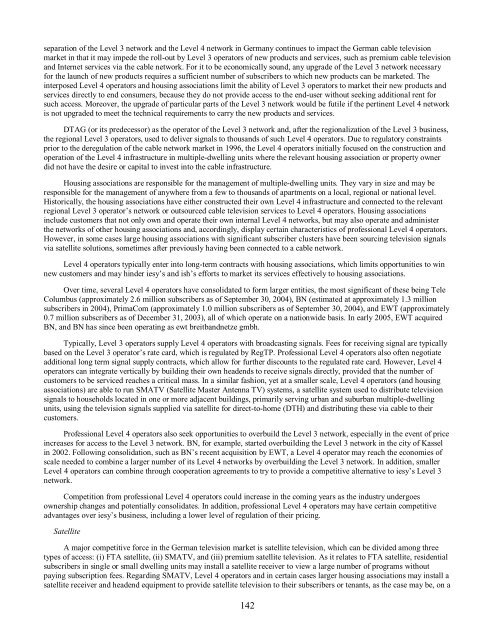iesy Repository GmbH - Irish Stock Exchange
iesy Repository GmbH - Irish Stock Exchange
iesy Repository GmbH - Irish Stock Exchange
You also want an ePaper? Increase the reach of your titles
YUMPU automatically turns print PDFs into web optimized ePapers that Google loves.
separation of the Level 3 network and the Level 4 network in Germany continues to impact the German cable television<br />
market in that it may impede the roll-out by Level 3 operators of new products and services, such as premium cable television<br />
and Internet services via the cable network. For it to be economically sound, any upgrade of the Level 3 network necessary<br />
for the launch of new products requires a sufficient number of subscribers to which new products can be marketed. The<br />
interposed Level 4 operators and housing associations limit the ability of Level 3 operators to market their new products and<br />
services directly to end consumers, because they do not provide access to the end-user without seeking additional rent for<br />
such access. Moreover, the upgrade of particular parts of the Level 3 network would be futile if the pertinent Level 4 network<br />
is not upgraded to meet the technical requirements to carry the new products and services.<br />
DTAG (or its predecessor) as the operator of the Level 3 network and, after the regionalization of the Level 3 business,<br />
the regional Level 3 operators, used to deliver signals to thousands of such Level 4 operators. Due to regulatory constraints<br />
prior to the deregulation of the cable network market in 1996, the Level 4 operators initially focused on the construction and<br />
operation of the Level 4 infrastructure in multiple-dwelling units where the relevant housing association or property owner<br />
did not have the desire or capital to invest into the cable infrastructure.<br />
Housing associations are responsible for the management of multiple-dwelling units. They vary in size and may be<br />
responsible for the management of anywhere from a few to thousands of apartments on a local, regional or national level.<br />
Historically, the housing associations have either constructed their own Level 4 infrastructure and connected to the relevant<br />
regional Level 3 operator’s network or outsourced cable television services to Level 4 operators. Housing associations<br />
include customers that not only own and operate their own internal Level 4 networks, but may also operate and administer<br />
the networks of other housing associations and, accordingly, display certain characteristics of professional Level 4 operators.<br />
However, in some cases large housing associations with significant subscriber clusters have been sourcing television signals<br />
via satellite solutions, sometimes after previously having been connected to a cable network.<br />
Level 4 operators typically enter into long-term contracts with housing associations, which limits opportunities to win<br />
new customers and may hinder <strong>iesy</strong>’s and ish’s efforts to market its services effectively to housing associations.<br />
Over time, several Level 4 operators have consolidated to form larger entities, the most significant of these being Tele<br />
Columbus (approximately 2.6 million subscribers as of September 30, 2004), BN (estimated at approximately 1.3 million<br />
subscribers in 2004), PrimaCom (approximately 1.0 million subscribers as of September 30, 2004), and EWT (approximately<br />
0.7 million subscribers as of December 31, 2003), all of which operate on a nationwide basis. In early 2005, EWT acquired<br />
BN, and BN has since been operating as ewt breitbandnetze gmbh.<br />
Typically, Level 3 operators supply Level 4 operators with broadcasting signals. Fees for receiving signal are typically<br />
based on the Level 3 operator’s rate card, which is regulated by RegTP. Professional Level 4 operators also often negotiate<br />
additional long term signal supply contracts, which allow for further discounts to the regulated rate card. However, Level 4<br />
operators can integrate vertically by building their own headends to receive signals directly, provided that the number of<br />
customers to be serviced reaches a critical mass. In a similar fashion, yet at a smaller scale, Level 4 operators (and housing<br />
associations) are able to run SMATV (Satellite Master Antenna TV) systems, a satellite system used to distribute television<br />
signals to households located in one or more adjacent buildings, primarily serving urban and suburban multiple-dwelling<br />
units, using the television signals supplied via satellite for direct-to-home (DTH) and distributing these via cable to their<br />
customers.<br />
Professional Level 4 operators also seek opportunities to overbuild the Level 3 network, especially in the event of price<br />
increases for access to the Level 3 network. BN, for example, started overbuilding the Level 3 network in the city of Kassel<br />
in 2002. Following consolidation, such as BN’s recent acquisition by EWT, a Level 4 operator may reach the economies of<br />
scale needed to combine a larger number of its Level 4 networks by overbuilding the Level 3 network. In addition, smaller<br />
Level 4 operators can combine through cooperation agreements to try to provide a competitive alternative to <strong>iesy</strong>’s Level 3<br />
network.<br />
Competition from professional Level 4 operators could increase in the coming years as the industry undergoes<br />
ownership changes and potentially consolidates. In addition, professional Level 4 operators may have certain competitive<br />
advantages over <strong>iesy</strong>’s business, including a lower level of regulation of their pricing.<br />
Satellite<br />
A major competitive force in the German television market is satellite television, which can be divided among three<br />
types of access: (i) FTA satellite, (ii) SMATV, and (iii) premium satellite television. As it relates to FTA satellite, residential<br />
subscribers in single or small dwelling units may install a satellite receiver to view a large number of programs without<br />
paying subscription fees. Regarding SMATV, Level 4 operators and in certain cases larger housing associations may install a<br />
satellite receiver and headend equipment to provide satellite television to their subscribers or tenants, as the case may be, on a<br />
142

















